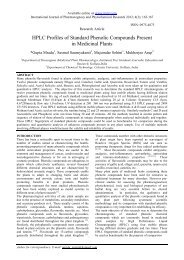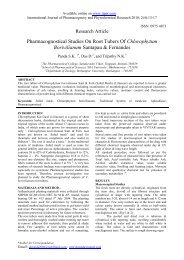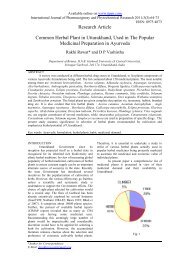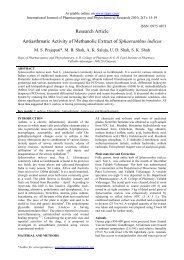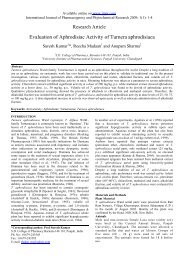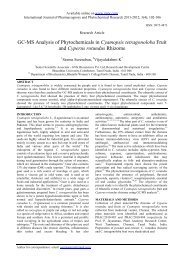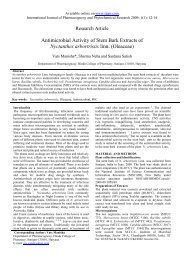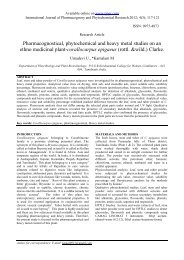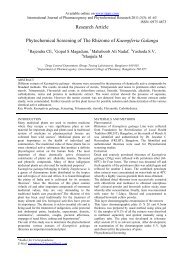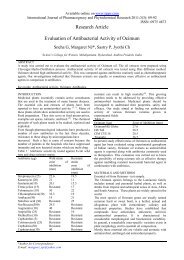antimicrobial activity of artemisia abrotanum and artemisia pallens
antimicrobial activity of artemisia abrotanum and artemisia pallens
antimicrobial activity of artemisia abrotanum and artemisia pallens
You also want an ePaper? Increase the reach of your titles
YUMPU automatically turns print PDFs into web optimized ePapers that Google loves.
Suresh et al. / Antimicrobial <strong>activity</strong> <strong>of</strong> Artemisia <strong>abrotanum</strong>…<br />
Table 1: Antibacterial <strong>activity</strong> <strong>of</strong> the ethanolic extracts <strong>of</strong> Artemisia <strong>abrotanum</strong> <strong>and</strong> Artemisia <strong>pallens</strong> by cup<br />
plate method<br />
S.No Organisms<br />
Diameter <strong>of</strong> Zone <strong>of</strong> Inhibition in mm<br />
Artemisia <strong>abrotanum</strong><br />
Conc (mg/ml)<br />
Artemisia <strong>pallens</strong><br />
Conc (mg/ml<br />
10 20 30 STD 10 20 30 STD<br />
GRAM POSITIVE STRAINS<br />
1 Bacillus subtilis 00 00 00 15.0 00 00 00 15.0<br />
2 Bacillus<br />
-- 18.5 20.6 24.8 21.0 24.5 27.6 30.0<br />
stearothermophilus<br />
3 Micrococcus luteus -- 19.3 20.1 23.4 22.2 24.2 26.2 31.4<br />
GRAM NEGATIVE STRAINS<br />
1 Klebsiella pneumoniae -- 12.3 14.4 20.4 21.1 24.3 27.4 32.3<br />
2 Pseudomonas cepacia 24.6 26.6 28.6 31.4 10.1 17.3 19.6 24.8<br />
3 Salmonella typhi 10.1 11.1 13.0 15.7 10.9 20.1 18.0 20.1<br />
Preparation <strong>of</strong> micro organism<br />
One loop-full <strong>of</strong> microorganism was inoculated into 100<br />
ml <strong>of</strong> sterile medium <strong>and</strong> incubated for 24 h at 37º C for<br />
bacterial culture <strong>and</strong> for 48 h at 27º C for fungal culture.<br />
After 24 h / 48 h <strong>of</strong> incubation 1 ml <strong>of</strong> broth containing<br />
the microorganism was added into 9 ml <strong>of</strong> peptone<br />
water. Ten fold serial dilutions were made in the range<br />
<strong>of</strong> 10 –1 to 10 –8 . 100 μl <strong>of</strong> the dilutions ranging from 10 –5<br />
to 10 –8 were spread on the sterile nutrient agar/SDA<br />
plates <strong>and</strong> kept at 37º C or 27º C for 24 h / 48 h. The<br />
numbers <strong>of</strong> colony forming units were counted <strong>and</strong><br />
numbers <strong>of</strong> microorganisms in each ml <strong>of</strong> stock culture<br />
were calculated. 3, 4<br />
St<strong>and</strong>ard drugs<br />
Penicillin (1mg/ml) diluted with dimethylsulphoxide was<br />
used as st<strong>and</strong>ard antibacterial drug. Amphotericin - B<br />
(500 μl/) in sterile water was used as st<strong>and</strong>ard antifungal<br />
drug. Dimethylsulphoxide was used as a control for the<br />
study.<br />
Screening <strong>of</strong> antibacterial <strong>and</strong> antifungal <strong>activity</strong> by<br />
cup plate method<br />
The antibacterial <strong>and</strong> antifungal <strong>activity</strong> <strong>of</strong> ethanolic<br />
extracts <strong>of</strong> Artemisia <strong>abrotanum</strong> <strong>and</strong> Artemisia <strong>pallens</strong><br />
were evaluated by cup plate method using different<br />
dilutions viz., 10 mg/ml, 20 mg/ml <strong>and</strong> 30 mg/ml.<br />
Sterilized nutrient agar plates were prepared under<br />
aseptic conditions. Six mm diameter holes were made in<br />
the agar plates using a sterile borer. 0.1 ml <strong>of</strong> the test<br />
organisms was spreaded on agar plates. Samples,<br />
st<strong>and</strong>ard drug <strong>and</strong> the solvent control (DMSO) were<br />
added into each hole separately. The plates were<br />
maintained at +4º C for 1 h to allow the diffusion <strong>of</strong><br />
solution into the agar medium. The plates were<br />
incubated at 37ºC for 24 h for bacteria <strong>and</strong> 28ºC for 48h<br />
for fungi. The zone <strong>of</strong> inhibition was measured using<br />
5, 6, <strong>and</strong> 7<br />
antibiotic zone reader.<br />
Determination <strong>of</strong> Minimum Inhibitory<br />
Concentration:<br />
Minimum Inhibitory Concentration was determined by<br />
two-fold serial dilution method. A series <strong>of</strong> test tubes<br />
were prepared containing the same volume <strong>of</strong> media<br />
inoculated with the test organism (the inoculums may<br />
vary from 10 3 to 10 6 cells per milliliter). Drug was added<br />
to the tubes in a stepwise dilution by a factor <strong>of</strong> 2 (two<br />
fold serial dilution) that is if the concentration <strong>of</strong> drug in<br />
the first tube is 500 mg/ml, in the second tube it will be<br />
250 mg/ml <strong>and</strong> in the third 125 mg/ml <strong>and</strong> so on.<br />
Cultures were incubated at 24 h for bacteria at 37ºC <strong>and</strong><br />
48 h for fungi at 27ºC. One tube was left without drug to<br />
serve as a positive control for the growth <strong>of</strong> the<br />
organism. Tubes are inspected visually to determine the<br />
growth <strong>of</strong> the organism indicated by turbidity. 7<br />
RESULTS AND DISCUSSION<br />
The ethanolic extract <strong>of</strong> AA was found to be effective<br />
against various bacteria as indicated by the zone <strong>of</strong><br />
inhibition. Maximum inhibition was obtained against<br />
Pseudomonas cepacia (28.6 mm) followed by Klebsiella<br />
pneumoniae (26.4 mm), Microccus luteus (25.4 mm),<br />
Salmonella typhi (22.0 mm) <strong>and</strong> Bacillus<br />
Table2: Antifungal <strong>activity</strong> <strong>of</strong> the ethanolic extract <strong>of</strong> Artemisia <strong>abrotanum</strong> <strong>and</strong> Artemisia <strong>pallens</strong> by cup plate<br />
method:<br />
Diameter <strong>of</strong> Zone <strong>of</strong> Inhibition in mm<br />
Sl.N<br />
o<br />
Organisms<br />
Artemisia <strong>abrotanum</strong><br />
Conc (mg/ml)<br />
Artemisia <strong>pallens</strong><br />
Conc (mg/ml)<br />
10 20 30 STD 10 20 30 STD<br />
1 C<strong>and</strong>ida albicans 05 15 16 19 00 05 16 23<br />
2 Saccharomyces cerevisiae 03 16 17 26 00 09 10 24<br />
3 Trichosporon beigelii 03 15 17 21 03 16 17 26<br />
IJPPR June 2011 -August 2011, Volume 3, Issue 2(18-21) 19



